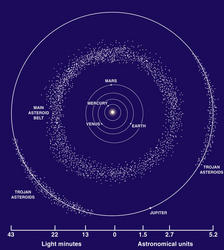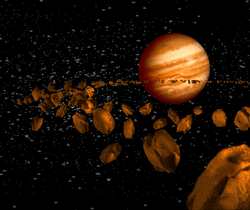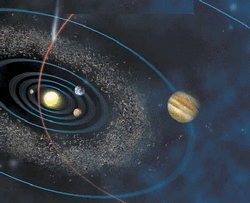Asteroid Belt
The Rockies
Most asteroids are rocky bodies that orbit the Sun between Mars and Jupiter in a "Main Asteroid Belt" that is centered around 2.7 times the Earth-Sun distance (astronomical unit or AU) from Sol. Two "clouds" of icy asteroids 60° ahead and behind Jupiter (and at or near Jupiter's orbital distance from the sun) are called "Jupiter Trojans" (diagram), while two similar objects in Mars orbit are called "Martian Trojans." Some asteroids have been found inside Earth's orbit (including many Near Earth Objects), while others -- including burnt out or dormant comets, such as perturbed Edgeworth-Kuiper Belt objects called "Centaurs" -- are located beyond Saturn's orbit. Indeed, many have orbits that cross Earth's path (see orbit diagram of near-Earth Asteroid 4179 Toutatis), and while small asteroidal fragments hit the Earth every day as meteorites, bigger asteroids are surmised to have landed with impacts that killed off a significant share of life on the planet in times past (see schematic diagram of the life history of cometary and asteroidal material by William K. Hartmann). While most asteroids may be only the size of pebbles, 16 asteroids have a diameter of 240 km (150 miles) and Ceres, the largest, has a diameter of about about 914 km (568 miles). (See an animation of Ceres's orbit around the Sun, with a table of basic orbital and physical characteristics.)
It has been estimated that the total mass of the Main Asteroid Belt may total less than 1/1000th of the mass of the Earth. Indeed, if all asteroids down to the size of meter- or yard-sized boulders or less were combined together, the resulting object would measure less than 1,300 to 1,500 km (810 to 930 miles) across, which is less than one third to one half the diameter of the Earth's Moon. The Main Asteroid Belt is only a small remnant of the material that once resided in the region between Mars and Jupiter, but once may have contained between two to 10 Earth masses of material (Dan Durda, "Ask Astro," Astronomy, December 2000). However, T-Tauri-type Solar winds from a very young Sun, gravitational perturbations from Jupiter developing nearby, and dynamic interactions with other large planetesimals and protoplanets during the first 100 million years, and continuing collisional grinding over the following 4.5 billion years after the formation of the planets, interfered with the formation of a substantial, single planet and caused most of the mass to be lost to the rest of the Solar System and interstellar space.
Based on the composition of meteorites found on the Earth, most asteroids may be composed of three materials: mostly (92.8 percent) silicates (stone); metals (5.7 percent) iron and nickel; and the rest as a mix of the those materials and carbon-rich substances. Asteroids located closer to Mars and Earth that exhibit the same spectra are composed of rocky minerals ("stone") mixed with iron. In contrast, asteroids located farther away from the Sun on the Jupiter side of the Main Asteroid Belt are generally darker, redder, and more icy, presumably because they were not as well heated by the Sun and so have a composition more like the primordial, circum-Solar dust disk out of which the outer planets accreted about 4.5 billion years ago. Thus, the outer asteroids may more closely resemble the icy planetary bodies of the Edgeworth-Kuiper Belt and Oort Cloud.
Analysis of data collected by spacecraft sent to a sample of asteroids since the 1990s and estimation of rotation speeds for a large number of asteroids have led to a startling conclusion. As of late 2001, no known asteroid larger than 200 meters (656 feet) across has been found to rotate faster than once every 2.2 hours. As a result, planetary astronomers infer that, over time, repeated collisions appear to have reduced most asteroids larger than a couple hundred meters (or yards) into "rubble piles" that are only loosely held by their weak gravity, which fly apart if spun too fast. For example, it has been estimated that asteroid Mathilde has a density close to that of water. Smaller asteroids, however, should be solid bodies because the shattered fragments of an asteroidal collision should easily escape their feeble gravity and fly off into space instead of settling back on their surface as regolith.
Try the Orbit Viewer, originally written by Osamu Ajiki of AstroArts and modified by Ron Baalke of NASA's Jet Propulsion Laboratory, to see real-time orbit animations of the known asteroids, Edgeworth-Kuiper ice bodies, comets, and planets



